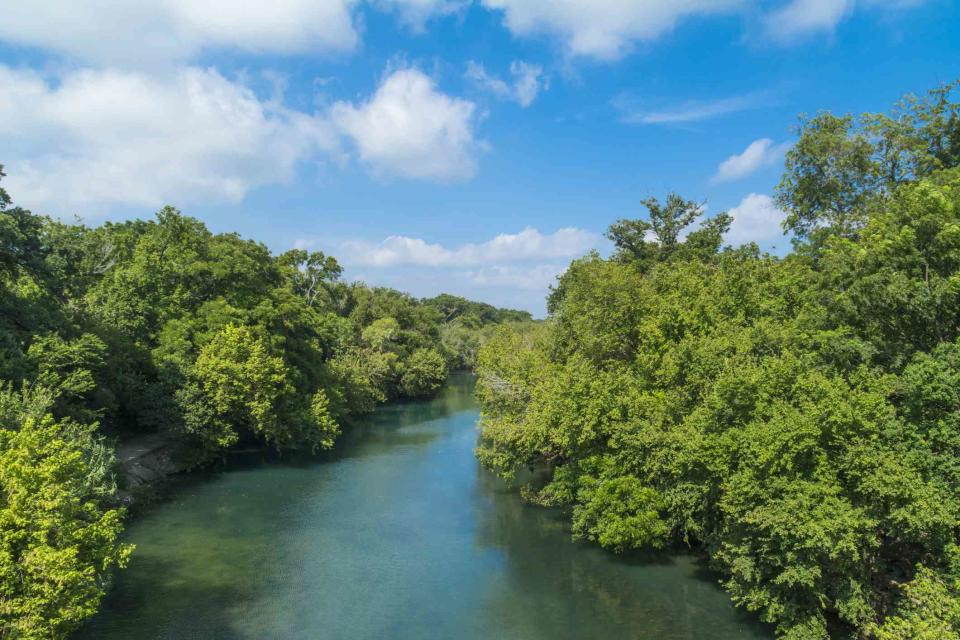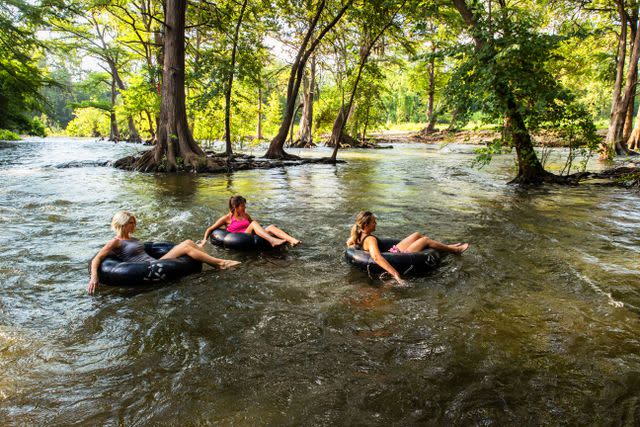I’ve Never Seen Rivers As Clear And Blue As They Are In Texas—Here's Why
After moving to Texas, I realized the waters here are of a different, prettier kind.

Getty Images/Grexsys
When I first moved to Texas, of course I was struck by the natural beauty of the state, in all of its varied regions and topographies, from beaches to mountains to desert lands to rolling hills. However, something that I noticed especially as the renowned scorching temperatures showed their worst was just how much people love Texas’ rivers—floating down them, kayaking, or simply taking a dip to stave off the heat. Even more so, I discovered that Texas rivers weren’t quite like the ones I’d seen or floated down before. They were, surprisingly, gorgeous. Blue-green, clear, and refreshing cold.
As a Georgia native who has lived in other states as well, clear, blue waters are not nearly considered the norm for rivers. Brown and murky come to mind, actually. And while the gulf waters of Texas beaches might not be known for being necessarily the clearest or bluest—to put it mildly—I came to realize that Texans don’t seem to mind, because they have plenty of other options for water-based respite. Primarily, the beautiful lakes, rivers, and swimming holes that abound.
Texas rivers—at the very least, in my region of Central Texas and Hill Country—have always seemed to be in a beloved class all their own. As it turns out, those beautiful, blue-green, clear waters are indeed unique. Here’s how they differ, and where to find them.
Why Makes Texas River Waters Clear and Blue?

Brown V. Cannon III
Actually, it can come down to a few different factors that affect the color and clarity of river waters, but generally it can be attributed to two main reasons.
Limestone
Most prominently in Texas Hill Country and Central Texas, clearer, bluer waters can sometimes be attributed to the abundance of natural deposits and quarries of limestone that are native to the area. Limestone is composed primarily of calcium carbonate, which breaks down into small crystals that mix into the water, reflecting sunlight for a beautiful blue color.
Natural springs
Within some Texas rivers and swimming holes, there are spring-fed waters that keep to an ideal cool-to-cold temperature year-round, as well as maintain a pale blue or green hue that you can see through, often right to the bottom. The water comes from underground sources that are filtered and purified as they travel through layers of rock and soil, resulting in a more clean, clear water. The bottom can also at times be limestone, not squishy mud, which again contributes to the unique coloring.
Where To Find The Best Rivers

Robbie Caponetto
While more naturally blessed overall on average, Texas rivers are not all perfectly clear or blue. However, you’ll find many options, particularly in Texas Hill Country and Central Texas, to behold the phenomenon and take advantage of it with swimming, tubing, or kayaking. Below are some of Texans’ favorites for enjoying.
Related: The Best Tubing Rivers In Texas To Float When It’s Hot Outside
Guadalupe River
The Guadalupe River is easily the most well-known tubing river in the entire Lone Star State. The 230-mile river runs from Central Texas all the way to the Gulf of Mexico. The most popular stretches to float are in the Texas Hill Country, especially near New Braunfels, Canyon Lake, San Marcos, and San Antonio. Guadalupe River State Park offer four miles of river frontage.
Blanco River
This idyllic river is not as packed with people or flowing quite as rapidly as the Guadalupe, offering a more quiet spring-fed respite to float down. It’s pretty shallow along most of the way, which can vary depending on rainfall.
Frio River
One of the most beautiful places to float, the Frio River is cool and calm. You’re able to enter from Garner State Park, which is located more remotely in Texas Hill Country near Concan around an hour-and-half drive from San Antonio.
Comal River
The spring-fed Comal River moseys through New Braunfels until eventually reaching the Guadalupe River. You can expect the water to be between 70 and 72 degrees year-round, and the floating stretch is just under three miles.
San Marcos River
This Hill Country river is another extremely popular place to float, particularly for the college kids at Texas State University in San Marcos. This spring-fed river is a tributary of the Guadalupe, which means it boasts cool temperatures year-round.
For more Southern Living news, make sure to sign up for our newsletter!
Read the original article on Southern Living.

